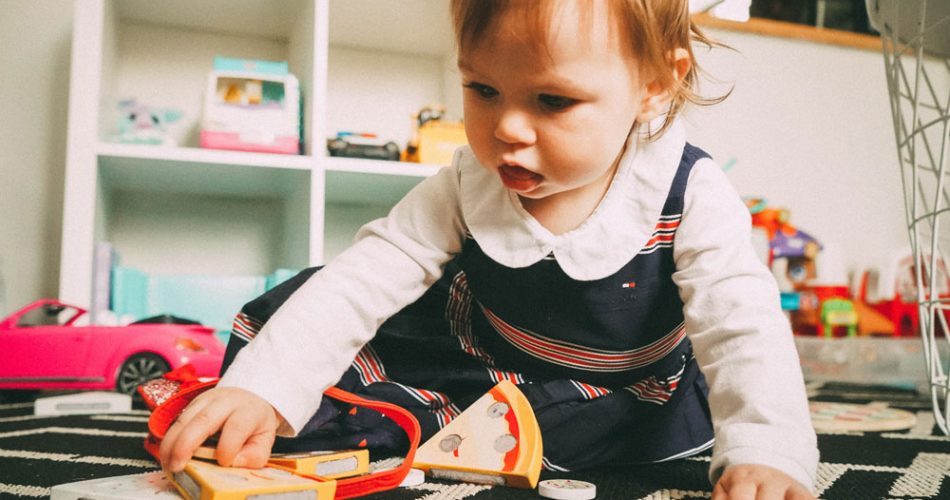“Play is the work of the child.”
— Maria Montessori
The Early Childhood Environment Rating Scales defines free play as when “a child is permitted to choose materials and companions and, as far as possible, manage play independently.” Through free play, children can make their own choices about how they spend their time.
How does free play support children’s learning?
- It offers children the chance to make a plan and make choices to carry out that plan while navigating challenges along the way. These experiences build executive function skills, which allow children to follow multi-step directions, avoid distractions, control their responses, make adjustments and persist when solving problems. These skills are critical to success in school and in life.
- It allows children to learn social skills as they choose playmates. Through social play, toddlers begin to express their own wants and needs. They begin to notice how others are feeling. Preschoolers develop more complex pretend play, negotiating the rules and roles of the play, considering other’s perspectives and solving conflicts.
- It gives children a chance to practice and refine new skills. Whether it’s trying out new words, sorting and counting, to sharing with others and taking turns, free play allows children the practice they need to master all those new skills.
Free play does not mean the children have free reign over a classroom without limits while teachers stand by. It does not mean giving up opportunities for learning. Here are five tips to keep free playtime running smoothly.
1. Avoid overcrowding
- Arrange the space with separate areas for different types of play, based on the development of the children in your group. For infants, this could include a quiet area for books and pictures, and a separate active play area with a mat for crawling and tumbling. For toddlers and 2 year olds whose play is becoming more complex, add a special block area with low storage and a space for building. You could also create a separate space for pretend play with dolls and props. Observe closely to see which areas need more space or other adjustments.
- For preschoolers, set up a system that limits the number of children in each center so there is enough space and materials for play. Here are a few ideas:
- Hang pictures or signs at each center that show the number of children allowed in the space at one time.
- Have children “check in” to each center using some type of visual, so others can see when a center is full. For example, if four children are allowed in the block area, add a laminated poster in the center with spots for four children to clip their name tag when they are playing in the center.
2. Help manage popular centers
When you use a system to limit the number of children at each center, the most popular centers fill up fast. To reduce conflict, set up a system so children get an equal chance to play. For example, children sign their name on a “waiting list” in the center to be the next in line when a child leaves the area. You can also use a kitchen timer to set an agreed upon waiting time for children in the center. These systems take time for children to learn, so be patient and consistent for children to learn to wait for their chance.
3. Offer opportunities for solo time
Everyone needs a chance to get away from the action now and then. Set up areas of the classroom where just one or two children can go for quieter play on their own, such as a single seat in a quiet corner with a few books or toys, or a listening center with headphones. You may start to notice fewer conflicts as children have the opportunity to step away and calm their bodies in a quiet space.
4. Adjust your schedule to allow longer blocks of time
Do you ever feel like you’re always transitioning from one activity to the next? Take a look at your schedule and see what adjustments you can make to allow for longer, uninterrupted blocks of free play time with fewer transitions. These longer blocks allow children to become deeply engaged in more complex activities, and allow more children to get a chance to play at the most popular centers. They also reduce the added stress of managing multiple transitions.
5. Use free play as learning time
During free play, watch closely and you’ll notice ripe opportunities for teaching while children’s minds are focused and engaged on play activities. Take the time to follow and lead while you turn everyday moments into learning opportunities.
- Follow children’s lead during play, joining their activities and introducing concepts along the way. Watch this video of a teacher introducing vocabulary by labeling objects and actions while playing in the dramatic play center.
- Lead activities with small groups of interested children during free play time. This smaller group setting allows you to introduce new concepts, observe what individual children know, and see where children may need more support or a different challenge. Watch this video of a teacher leading a math activity during center time.
As you work to make free play a pleasant learning time, remember that you don’t need to do it alone. If you are a Quality First participant, your coach is available to provide expert guidance, support and assistance as you put new strategies into place. If you are not a Quality First participant, we invite you to apply today.
At Quality First, we love to hear from you. Share your new and innovative practices so others can be inspired. Send an email to QualityFirst@FirstThingsFirst.org.
